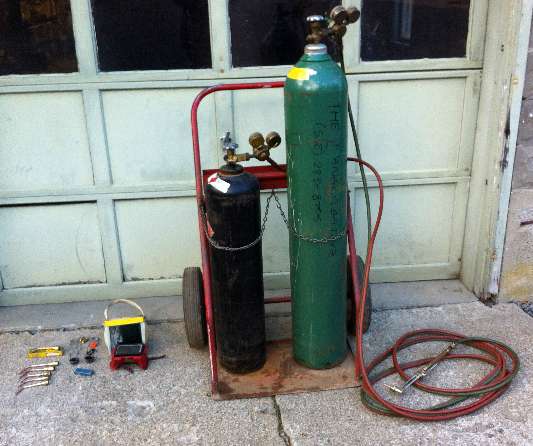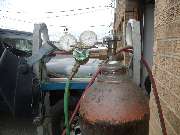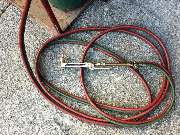The MGA With An Attitude
OXY-ACETYLENE TORCH (Gas Welder) - TS-401




The oxygen-acetylene torch comes in handy for a wide variety of odd jobs, heating anything to high temperature, bending thick metal plates, welding metals (mostly steel), cutting through steel plate up to 6-inches thick, and many of other things that require lots of heat. Most people can go their entire life without having one of these in hand, but if you do much auto restoration work the thing can be very handy on occasion.

The oxygen and acetylene tanks are available in several sizes. The tanks shown in the first picture are mid size tanks. They hold a lot of gas and can do a lot of work before needing to be refilled. The oxygen tank is the taller one, holding 140 cubic feet of gaseous oxygen at up to 2200 psi pressure. The smaller tank holds 120 cubic feet of acetylene at less then 300 psi pressure in liquid form, but absorbed into other materials inside the tank.
Notice the size of the wheeled cart. That one can hold an even larger set of tanks with about three times the volume. Very few people have any use for the larger tanks. When doing some restoration work and other odd occasional jobs around the home shop my mid size tanks last several years before needing to be refilled. There are also smaller tanks about knee high with half the volume that may be more appropriate for a home shop. And there are extra small tanks you might carry around in hand (shown at right) for the occasional hobbyist.
A torch kit may include the pressure regulators, a regulator wrench, hoses, torch body, cutting head, a few different sizes of flame tips, a flint striker, tip cleaner probes, and a pair of dark goggles. An inexpensive torch kit might be under $100 new if you shop around. The tanks are expensive. You can buy the tanks, or you can rent them for a moderate monthly fee, depending on how long you may need the tanks. I originally rented my tanks and was given a credit for up to two years rental fees toward the purchase price if I decided to buy them later, which I did. I have now owned them for 35 years. When you buy the tanks you get a title with the tank serial numbers recorded. When they need to be refilled they are usually exchanged, and you get paper work showing serial numbers of the exchange tanks.
On 4/22/2012, Russ Sharples wrote:
"My dad had a oxy-acetylene welding rig. .... We found the cylinders. The acetylene cylinder has a re-inspection date of November 1972 marked on it. So we have a couple of 40 year old gas cylinders. They look to be in good shape in that they have been stored in a barn all that time, dry and cool. From what I can find on the web, the acetylene tank probably has pretty dangerous contents. Do you know anything about disposal of this kind of stuff? My next stop would be to call the fire department and ask them. Given I don't know anything about these cylinders and how to handle them I am pretty much not going to even touch them until I get advice from someone who is more experienced with such things".
First of all, it is not dangerous, so stop worrying about not touching it. Second of all, you seem to have a bit of treasure there, so do not despair.
To use the stuff, or even check the contents, you need to find the pressure regulators with the welding kit. Screw the regulators onto the tanks. Every gas welding set with torch, hoses and regulators will have a combination wrench included to work the valves. So look around and find the wrench. The oxygen bottle and regulator and hoses have right hand threads. The acetylene bottle and regulator and hoses have left hand threads. Once the regulators are mounted you can crack the main valve open to check tank pressure.
Freshly filled oxygen tank would be about 2200 psi. Oxygen remains a gas at that pressure, so it takes a lot of pressure to store a lot of gas. Freshly filled acetylene tank would be about 300 psi. Acetylene gas by itself under high pressure is explosive, so there is more to the contents of the bottle. It is filled with a sponge like material called Kapok (I think). That in turn is saturated with acetone (I think). When gaseous acetylene is put into the tank it gets absorbed into the acetone and becomes liquid. This stores a lot of acetylene in liquid form at relatively lower pressure, so the bottle can be somewhat smaller than the oxygen bottle.
When the tanks are stored long term or transported, you remove the regulators and install the tank safety cap to protect the main valve. The cap is a tall dome of heavy steel, sort of like a bottle nose dolphin's nose. The cap screws onto a large thread at the neck of the tank. Every tank should have a safety cap, so you should find those somewhere near the tanks, as well as the regulators and wrench and hoses and torch(s) and a flint striker and maybe dark tinted goggles. You will discover that all of the acetylene supply threaded fittings have left hand threads so the regulators and hoses cannot be accidentally switched.
The tanks are extremely robust. A military tank could run over them without a scratch. It is important to install the safety cap for transport. Without the safety cap, if the tank falls over it could break the pipe below the main valve, in which case the thing will take off like a rocket while it is expelling gas at high pressure. That part is dangerous, as it can break through a cinder block wall (so don't do that). Otherwise the tanks and related equipment are perfectly safe to handle. When in use the acetylene bottle must remain upright, so the tanks are usually chained to a wall or chained into a mobile cart. When closed and capped for transport, the bottles can lay in their side (just don't let them roll around).
Age since last inspection is not critical, as long as the tanks have not been abused, or sitting in water to go rusty. I just checked the prior receipt on mine, and the last time I had mine refilled was August 18, 1999. As fate would have it, I have medium size tanks and don't use them very much (but they sure are handy when needed). If you like you can go ahead and use them until they run empty. You are not obligated to take them in for inspection. That will be done at the time the tanks are returned for refill.
When empty you take them in to be refilled. In most cases they will be exchanged for full tanks on the spot, so no waiting. You always get a receipt with a date and the serial numbers of the tanks you take home. So it would be nice if you could find the prior receipt, even if it is from 1975. If the tanks are returned early, before the expiration date, they don't need to be inspected again. If the tanks are returned after the inspection date expiration, then you may have to pay for a tank inspection fee (which is not very expensive). In my entire life I have never heard of a tank failing inspection, no matter how old it is. If they pass a pressure test they are refilled and put back into service.
If the tanks are owned rather than rented, then there should be a title for the tanks, similar to a title for a car. It would be even nicer if you can find a title of ownership or bill of sale, because the tanks are worth several hundred dollars. These days it sort of surprises the supply company people when I produce the title to show that I own the tanks. If you have a use for the gas welding equipment, then hang onto it. If you will never use it, then you can sell the tanks (and the torch kit), if you can find the title. If you cannot find the title, or the last exchange receipt, then you might call the nearest welding supply company to inquire about what you might do with the things. No one owns the tanks unless a title or receipt can be produced. If no one has proof of ownership, then I think possession is nine points of the law, meaning you own them by default. The problem then is how to get a legal title in your name, which is sort of like having a car with no title and trying to get the state to issue a title in your name. It is not supposed to be easy, but if you follow all the rules and jump through enough hoops I'm sure it can be done.
|